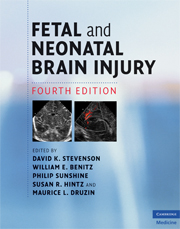Book contents
- Frontmatter
- Contents
- List of contributors
- Foreword
- Preface
- Section 1 Epidemiology, pathophysiology, and pathogenesis of fetal and neonatal brain injury
- Section 2 Pregnancy, labor, and delivery complications causing brain injury
- Section 3 Diagnosis of the infant with brain injury
- 16 Clinical manifestations of hypoxic–ischemic encephalopathy
- 17 The use of EEG in assessing acute and chronic brain damage in the newborn
- 18 Neuroimaging in the evaluation of pattern and timing of fetal and neonatal brain abnormalities
- 19 Light-based functional assessment of the brain
- 20 Placental pathology and the etiology of fetal and neonatal brain injury
- 21 Correlations of clinical, laboratory, imaging, and placental findings as to the timing of asphyxial events
- Section 4 Specific conditions associated with fetal and neonatal brain injury
- Section 5 Management of the depressed or neurologically dysfunctional neonate
- Section 6 Assessing outcome of the brain-injured infant
- Index
- Plate section
- References
16 - Clinical manifestations of hypoxic–ischemic encephalopathy
from Section 3 - Diagnosis of the infant with brain injury
Published online by Cambridge University Press: 12 January 2010
- Frontmatter
- Contents
- List of contributors
- Foreword
- Preface
- Section 1 Epidemiology, pathophysiology, and pathogenesis of fetal and neonatal brain injury
- Section 2 Pregnancy, labor, and delivery complications causing brain injury
- Section 3 Diagnosis of the infant with brain injury
- 16 Clinical manifestations of hypoxic–ischemic encephalopathy
- 17 The use of EEG in assessing acute and chronic brain damage in the newborn
- 18 Neuroimaging in the evaluation of pattern and timing of fetal and neonatal brain abnormalities
- 19 Light-based functional assessment of the brain
- 20 Placental pathology and the etiology of fetal and neonatal brain injury
- 21 Correlations of clinical, laboratory, imaging, and placental findings as to the timing of asphyxial events
- Section 4 Specific conditions associated with fetal and neonatal brain injury
- Section 5 Management of the depressed or neurologically dysfunctional neonate
- Section 6 Assessing outcome of the brain-injured infant
- Index
- Plate section
- References
Summary
Introduction
Hypoxic–ischemic encephalopathy (HIE) is a well-recognized clinical syndrome and the most common cause of acute neurological impairment and seizures in the neonatal period. Neonatal encephalopathy is a term used to describe newborns with acute neurological syndromes and encephalopathy that may be caused by diverse processes including hypoxia–ischemia, infections, inflammation, trauma, and metabolic disorders. Neonatal encephalopathy due to perinatal asphyxia can lead to neurological sequelae and cerebral palsy, but recent literature has shown that only a small percentage of children with cerebral palsy had intrapartum asphyxia as a possible etiology. More emphasis has been placed on antenatal events as having a greater association with cerebral palsy. Although newborns with neonatal encephalopathy may have antenatal risk factors associated with other findings, such as delayed onset of respiration, arterial cord blood pH less than 7.1, and multiorgan failure, the MRI most often shows signs of acute perinatal insult. Therefore, hypoxic–ischemic injury during the perinatal period can lead to a neurological syndrome in the newborn period, i.e., HIE, and subsequent neurological sequelae in the survivors. Recognizing and understanding hypoxic–ischemic encephalopathy are therefore important.
- Type
- Chapter
- Information
- Fetal and Neonatal Brain Injury , pp. 187 - 195Publisher: Cambridge University PressPrint publication year: 2009



